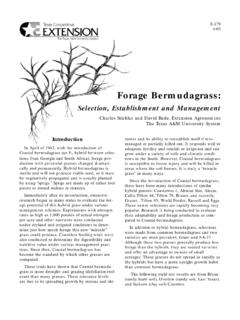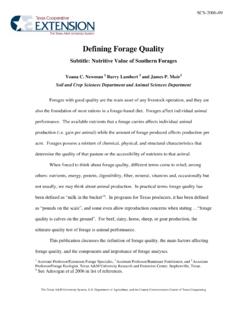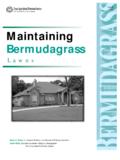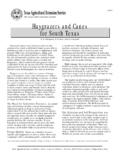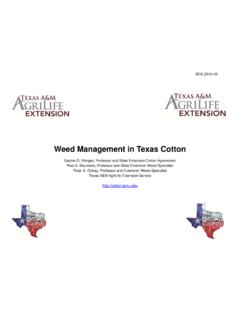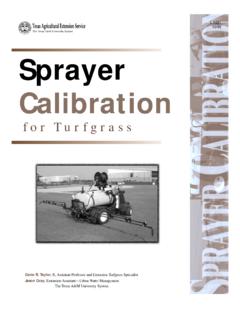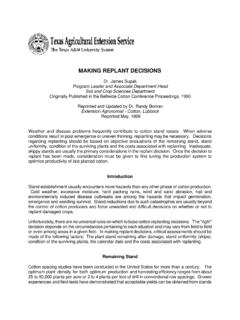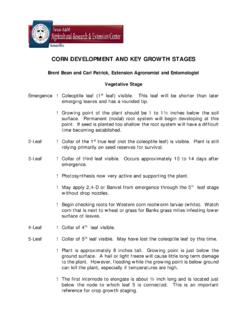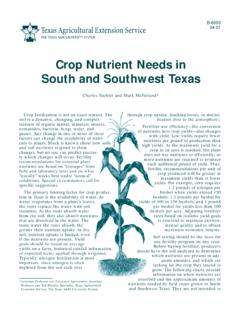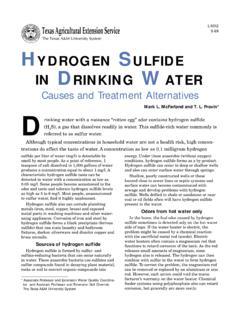Transcription of Renovation of Bermudagrass Pastures
1 Texas Agricultural Extension Service .. SCS-1999-07.. The Texas A&M University System .. Renovation of Bermudagrass Pastures Renovation is a practice or series of manage- The following summarizes Renovation practices ment practices which restores the vigor or and is given to help you select those which are makes new again . In pasture management, relevant to your operation. These include: Renovation refers to improvement of a perma- nent pasture by changed management. Reno- Minimum Extensive vation of Bermudagrass Pastures may be as Renovation Renovation simple as soil testing and applying proper fertilization; or, it may be as complex and Soil Testing Sub-soiling or chiseling intensive as destroying the existing sod, prepar- Fertilization Discing or plowing ing a seedbed and sprigging again.
2 The inten- sity and level of Renovation required depends Weed Control Sod-seeding on the reason for the decreased vigor, and the Prescribed Burning Replanting management goal of the producer. Although there are many reasons for Soil Testing and Fertilization Bermudagrass pasture decline, the following symptoms would indicate that Renovation The first Renovation practice should be exten- should be considered: sive soil testing and fertilization in accordance with the soil test recommendations. This 1) Reduced yields includes not only nitrogen, but also phospho- rous (P), potassium (K), lime, and any micronu- 2) Thin stands with bare ground showing trients needed. Soil testing different levels of and a decrease in amount and vigor of the soil profile would indicate the availability rhizomes of nutrients to plant roots ( , soil test the top 2 inches, from 2 to 6 inches, from 6 to 12.
3 3) Invasion of broadleaf weeds and inches). In many fields, potassium has been undesirable grasses depleted due to fertilization with nitrogen alone, along with the removal of hay from the 4) Rough soil surfaces pasture. Remember: 6 tons of hay/acre re- 5) Poor drainage moves not only 300 pounds of N, but also 60. pounds of P and 240 pounds of K/acre. Pro- 6) Poor water penetration in soil profile duction of high hay yields with N alone results in mining K from even those soils with 7) Accumulation of nutrients in the top 1- inherent high levels of K. Low levels of K in inch of soil the soil profile decreases rhizome growth and vigor, resulting in thin Bermudagrass stands. Dr. David H. Bade, Professor and Extension forage Specialist Educational programs conducted by the Texas Agricultural Extension Service are open to all people without regard to race, color, sex, disability, age, or national origin.
4 Texas Agricultural Extension Service Chester P. Fehlis, Deputy Director The Texas A&M University System College Station, TX. Weed Control Subsoiling, Chiseling, Discing, Plowing Weeds compete with Bermudagrass for water, These operations will partially destroy the sod, nutrients and sunlight. Weeds at establishment but are used to renovate Bermudagrass Pastures prevent good stands, and often result in under certain conditions. Subsoiling and plantings which do not cover for years or chiseling will eliminate compaction layers. which never obtain a good grass cover. Thin, This will loosen the soil and allow penetration weakened Bermudagrass stands from low of moisture in the soil profile, decrease water fertility, drought, or other causes cannot com- runoff, and aerate the soil for better root devel- pete with weeds and must be helped with opment.
5 Soil types which become very com- appropriate weed control. Result demonstra- pact and develop plowpans will respond to tions in Victoria County have shown that from equipment that loosens the soil below the 3 to 7 pounds of Bermudagrass will be pro- compaction layer. duced for each 1 pound of weeds controlled. More intensive discing or plowing will incor- Prescribed Burning porate organic matter in the soil, incorporate fertilizer and lime, destroy grassy weeds, Burning during the dormant period will remove scatter cut sprigs, and increase soil water excess dead forage and allow the soil to warm penetration. If done in the fall, it also allows earlier promoting faster green-up in the spring, for sod-seeding of legumes in the pasture. destroy some insects, winter weeds, and Fall s can be dry and can cause the desiccation weedy grasses.
6 The disadvantages of burning of rhizomes and sprigs. Intensive discing in the include fire hazards, removing stubble which fall has more risk than discing in late winter or protects the grass from late freezes, and allow- early spring. Cultivation or discing of hay ing more soil erosion. Timing is critical and Pastures is often desirable to smooth the soil must be done after weeds have emerged but surface, making haying easier. This is espe- before green-up. Waiting until later decreases cially true where fire ants are prevalent, or yields. Earlier burning removes stubble and where cattle were allowed to graze during wet allows for emerging weeds to outgrow the conditions. Bermudagrass . The best time is usually about 1. week prior to the last average frost date. Any of the above Renovation practices should be done during grass dormancy (winter), with A 150-acre pasture of Bermudagrass ( Coastal ) care taken to conserve soil moisture, especially was burned on February 10, 1987 in Falls in a drought.
7 County. Burning increased grass production by 143%, while decreasing weed production by Replanting 96%. A 4% increase in protein, a 2% increase in TDN, and a slight increase in the mineral Replanting of Bermudagrass stands should only content (Ca, P, K, Mg) of the forage was seen in be considered when inadequate live rhizomes the burned pasture. are left (< 25% stand). In a pasture which was once productive, this usually only happens after an extreme drought. The expense of this operation makes it prohibitive except under unusual conditions. The information given herein is for educational purposes only. Reference to commercial products or trade names is made with the understanding that no discrimination is intended and no endorsement by the Cooperative Extension Service is implied.
